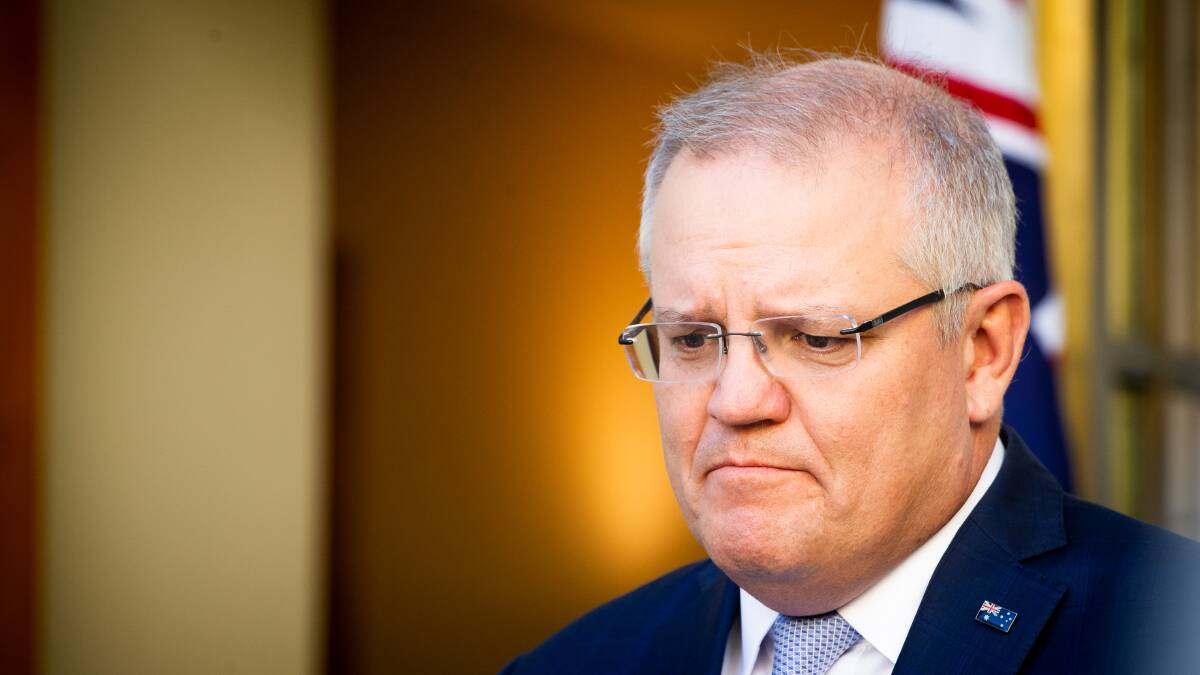
The second coronavirus wave in Victoria will leave up to 400,000 more Australians unemployed and cost the national economy $12 billion, Prime Minister Scott Morrison has revealed.
Subscribe now for unlimited access.
or signup to continue reading
Mr Morrison has also foreshadowed "arguably the most significant installment" in COVID-19 supports in the October 6 budget.
On Thursday, Mr Morrison said Treasury had provided updated economic forecasts for the nation's recovery, after Victorian Premier Daniel Andrews imposed stage three restrictions across regional Victoria and stage four restrictions in Melbourne.
According to the preliminary figures, the restrictions in August and September are expected to reduce the size of the real economy in the September quarter by between $7 billion and $9 billion.
Eighty per cent of the impact is likely to be felt in Victoria, with the measures expected to take a toll of between $6 and $7 billion on the state's economy.
"This is a heavy blow, a heavy blow," Mr Morrison said.
When taking into account supply chain impacts, and the effect on business confidence in other states, the cost of the lockdown is expected to rise to between $10 billion and $12 billion.
But of greater concern was the impact on unemployment, Mr Morrison said.
The unemployment rate was now expected to be higher than the forecast peak of 9.25 per cent and may now hit nearly 10 per cent.
However, Mr Morrison said this headline rate did not tell the full story.
The number of people who were effectively unemployed - which includes people who are still technically employed but have zero hours - is expected to rise by between 250,000 and 400,000.
It means the effective unemployment rate - which recently fell from around 13 per cent to approximately 11 per cent - will rise again.
"That is very concerning. That is very troubling but it is not unexpected," Mr Morrison said.
"These measures will have a very significant cost, and it will impact the recovery path, but the task doesn't change. We get on top of this issue in Victoria and we band together and we make this work."
Mr Morrison said he was in discussions with Treasurer Josh Frydenberg about further issues with the JobKeeper program, but did not provide any more detail.
He said the October budget would contain significant measures to address the economic fallout of the virus.
This would include announcements on industrial relations, skills, energy and manufacturing.
"The budget will be in October and that will be another significant, arguably the most significant installment in these announcements, in addition to those that have already been made over these many months," Mr Morrison said.
Mr Morrison said the support to date had been "unprecedented in this country".
"Right now let's not forget we've got $1 billion going into skills, which we've announced with the states and the Commonwealth, we've got $1.5 billion going to support 180,000 apprentices, we've got a $600 million-plus HomeBuilder program, we've got a $250 million entertainment industry program, we've got new incentives going into the film industry. That's on top of JobKeeper and JobSeeker and the $750 support payments that have gone in twice now in both quarters to welfare beneficiaries," Mr Morrison said.
Last month's economic and fiscal update had predicted the Australian economy would start to recover during the September quarter, as COVID-19 restrictions eased across most of Australia.
However the estimates were underpinned by the assumption Victoria would allow businesses to reopen in mid-August.
Instead, the state was forced to extend the lockdown, with hundreds of new cases of the virus being reported each day.
Meanwhile separate data has shown the toll the bushfires and pandemic have taken on Australia's tourism industry.
The Australian Bureau of Statistics says the number of tourism jobs fell 3 per cent between March 2019 and 2020, despite jobs in all industries growing 1.7 per cent in the same period.
It was the largest fall in tourism jobs since the bureau began monitoring them in 2004.
Accommodation services jobs were hardest hit, falling by 11,600.
However the data only captured the early stages of COVID-19, with international border closures only coming into effect on March 20. The June quarter release in late September expected to show the full impact of the virus on tourism, the ABS said.


